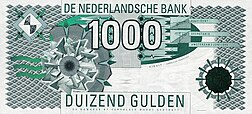| Nederlandse gulden (Dutch) fl. | |
|---|---|
 Last series of guilder banknotes | |
| ISO 4217 | |
| Code | NLG |
| Unit | |
| Unit | guilder |
| Plural | guilders |
| Symbol | ƒ |
| Denominations | |
| Subunit | |
| 1⁄100 | cent |
| Plural | |
| cent | cents |
| Banknotes | |
| Freq. used | ƒ10, ƒ25, ƒ50, ƒ100, ƒ250 |
| Rarely used | ƒ5 (withdrawn in 1995), ƒ1000 |
| Coins | |
| Freq. used | 5c, 10c, 25c, ƒ1, ƒ2+1⁄2, ƒ5 |
| Rarely used | 1c (withdrawn 1 March 1983), 1⁄2c, 2+1⁄2c (withdrawn 1948), 50c (withdrawn 1930) |
| Demographics | |
| User(s) | None, previously:
|
| Issuance | |
| Central bank | De Nederlandsche Bank |
| Website | www |
| Printer | Joh. Enschedé |
| Website | www |
| Mint | Royal Dutch Mint |
| Website | www |
| Valuation | |
| Inflation | 2.6% (December 2000) |
| Source | worldpress.org, 2000 est. |
| EU Exchange Rate Mechanism (ERM) | |
| Since | 13 March 1979 |
| Fixed rate since | 31 December 1998 |
| Replaced by euro, non cash | 1 January 1999 |
| Replaced by euro, cash | 1 March 2002 |
| 1 € = | ƒ2.20371 |
| This infobox shows the latest status before this currency was rendered obsolete. | |
The guilder (Dutch: gulden, pronounced [ˈɣʏldə(n)] ) or florin was the currency of the Netherlands from 1434 until 2002, when it was replaced by the euro.
The Dutch name gulden was a Middle Dutch adjective meaning 'golden',[1] and reflects the fact that, when first introduced in 1434, its value was about equal to (i.e., it was on par with) the Italian gold florin. The Dutch guilder was a de facto reserve currency in Europe in the 17th and 18th centuries.[2][3][4]
Between 1999 and 2002, the guilder was officially a "national subunit" of the euro. However, physical payments could only be made in guilders, as no euro coins or banknotes were available. The exact exchange rate, still relevant for old contracts and for exchange of the old currency for euros at the central bank, is 2.20371 Dutch guilders for 1 euro.[5] Inverted, this gives 0.453780 euros for 1 guilder.
Derived from the Dutch guilder are the Netherlands Antillean guilder (still in use in Curaçao and Sint Maarten) and the Surinamese guilder (replaced in 2004 by the Surinamese dollar).
- ^ J. Verdam, Middelnederlandsch Handwoordenboek, The Hague 1932 (reprint of 1994). In modern Dutch, the adjective still exists in certain fossilised forms such as het Gulden Vlies ('the Golden Fleece'). The modern equivalent is gouden.
- ^ Pisani-Ferry, Jean; Posen, Adam S. (2009). The Euro at Ten: The Next Global Currency. United States of America: Peter G. Peterson Institute for International Economies & Brueggel. ISBN 9780881325584.
- ^ The euro as a reserve currency lodz.pl
- ^ The Changing World Order, Ray Dalio
- ^ "Rules for exchanging guilder notes". De Nederlandsche Bank. Archived from the original on 12 January 2011. Retrieved 31 January 2011.